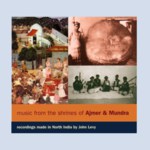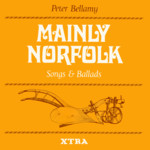> Folk Music > Records > Music From the Shrines of Ajmer & Mundra
Music From the Shrines of Ajmer & Mundra
 |
Music From the Shrines of Ajmer & Mundra Topic Records TSCD911 (CD, UK, 1995) |
Released under licence from Tangent Records;
Recordings and notes by John Levy
Naubat Shahnā’ī, and Kacchi Kafī: Some of the best Indian music is intended to be heard in the open, played either in musicians’ galleries over gateways or in courtyards. As one would expect, the instruments must be such as will carry. The subtleties of refined indoor music, with its gradual development of a rāg, would be unsuitable. But with classical naubat [1, 2], there are other subtleties, especially in the percussion. In the popular naubat [4, 6], it is the melody that counts.
Classical naubat is basically a music played over a gateway to mark the hours and is sysnonymous with playing pairs of naqqāra, kettle-drums struck with sticks—the tablā, struck with the fingers, is the naqqāra’s smaller brother. Other percussion, double-reed and brass instruments are usually added, and since the melody in that case is played on the shahnā’ī, the North Indian oboe, the combination is known as naubat shahnā’ī. The full band with brass and cymbals is seldom heard today, but the basic band survives. Naubat shahnā’ī is also played over the gateways to princely palaces and to Hindu temples, but in no case can the tradition last much longer. Few of the best gateway musicians are less than 60 years of age, and they virtually have no successors—money is very short nowadays in these establishments. The popular naubat is more likely to survive, being played by independent groups who are in constant demand for weddings and other auspicious occasions; popular naubat has nothing to do with the formal marking of hours.
On [3] an example of a rare form of Muslim devotional song is given, called Kacchi Kāfī, named after the small province of Kacch; nothing like it exists elsewhere. (The origin of kāfī is doubtful. Either it denotes the name of a rāg in which these songs used to be sung; or more probable, it derives from the Persian qāfiya, meaning a rhymed verse.) What is remarkable, apart from its great beauty, is the use of a shahnā’ī in the accompaniment. And because in popular naubat the Indian bagpipes (mashak) are often found, and will probably never be heard outside India, a solo for the mashak is also included.
Tracks
- Classical Naubat Shahnā’ī (Mundra)
(6.40)
Prabhatī, Dipchandī - Classical Naubat Shahnā’ī (Ajmer)
(12.41)
Rāgamalā, Tīntāl and Dādra - Kacchi Kāfī
(5.44)
Darbārī Kānāda, Dādra - Popular Naubat Shahnā’ī (Jabbalpur)
(10.20)
Thumrī - Mashak (Indian bagpipes)
(1.47)
folk tune - Popular Naubat Shahnā’ī (Bhopal)
(4.18)
Thumrī

